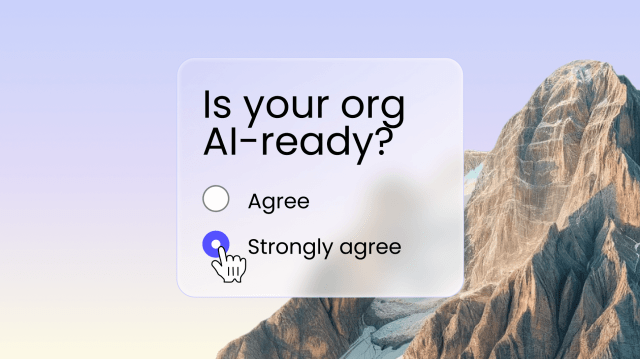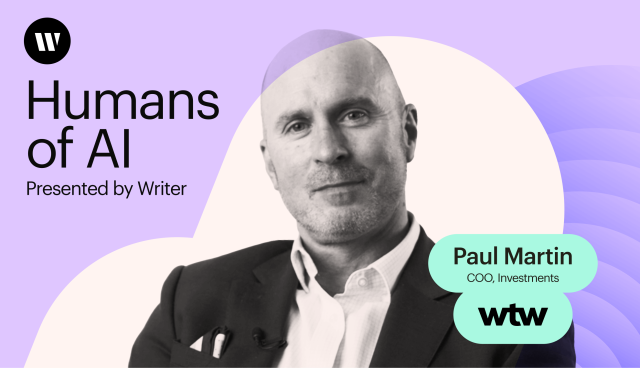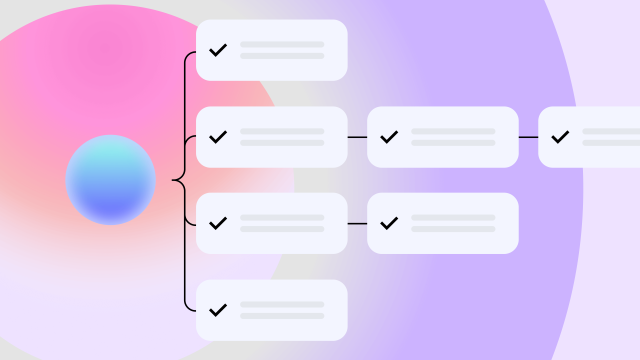Humans in the loop
– 11 min read
Fighting entropy with silicon and wire: Paul Dyrwal, Marriott International

You would expect the typical AI origin story to involve someone who saw it coming from miles away — a computer science prodigy who predicted the transformer revolution or a visionary entrepreneur who bet everything on machine learning. Paul Dywal, our latest guest on Humans of AI, has a story that’s messier and more instructive.
He spent nearly 20 years having one-sided conversations with machines that could barely understand him, bouncing between seemingly unrelated jobs, and stumbling into expertise he didn’t know he was building.
Paul shares his journey from early voice recognition software to leading generative AI at Marriott International, where he is using AI to streamline processes and reduce bureaucratic inefficiencies, enabling employees to focus on what matters most — providing exceptional hospitality.
- Paul’s diverse career spanning a design agency, Amazon, and ancestry.com, provided him with a broad skill set in human-machine interaction, UX research, and content management.
- Paul’s breakthrough moment with AI came around 2020 when he demoed GPT technology, recognizing its potential to simulate understanding and facilitate flowing conversations, unlike pre-transformer AI.
- At Marriott, Paul uses AI to reduce bureaucratic inefficiencies and improve processes, allowing 200,000 employees to focus more on providing exceptional guest experiences and less on mundane tasks.
- He emphasizes the importance of proper training and a focused approach to AI implementation, starting with personal productivity tools to gradually build user confidence and drive successful ROI initiatives.
Practicing human-machine conversation in 2002
To understand Paul’s journey, you need to know something about how he works. He describes himself as a “creative extrovert” — someone whose best ideas only emerge through conversation.
“I will have ideas and thoughts that only happen when I’m speaking,” he explains, “and they don’t happen if I’m sitting there in a closet with a beer alone at home.”
This might seem like a small personality quirk, but it became the foundation for everything that followed. Because in 2002, while most of us were still treating computers like glorified typewriters, Paul started having conversations with his computer.
“Maybe my real first interaction with a form of AI was I started using voice recognition software to type,” Paul says. “For 20 years at work, I spoke to my machine.”
He was accidentally training for a job that didn’t exist yet.
Unknowingly building the perfect AI resume
If you charted Paul’s career path, it would look like an erratic game of pinball. You’ve got a design agency, Amazon, ancestry.com, and some bouncing between UX research, product management, and content localization.
It’s a masterclass in the art of being accidentally prepared. With each new role and challenge came an opportunity to develop a new skillset, often without realizing it at the time.
But after 2008, Paul stopped job hunting entirely because opportunities began hunting him.
“Those roles came to me because somebody apparently saw something and asked me if I was interested,” he says.
What they likely spotted was his knack for understanding how humans interact with complex systems. At a design agency, he crafted an AI running coach that lived in earbuds. At Amazon, he shaped early Echo Show designs — devices that could see, hear, and respond to human needs.
Each gig seemed unrelated, but collectively they were building something powerful — a rare understanding of human-machine interaction across multiple domains.
“That pays off in AI, having helped lead design projects, been a product leader, been a leader in content, a leader in localization, a leader in research,” Paul explains. “What that allows one to do is understand the problem sets that you’re trying to solve for with modern, post-transformer AI.”
Then came the moment that would reshape everything, in the most unlikely of settings. A ferry ride conversation with a guy named Robert.
“He came up to me and said, ‘Hey, would you like to apply for this job on my team? I’d like to know if you’d like to lead research,'” Paul recalls. “I said, ‘Robert, I’ve never done that in my life.’ And in a very Amazonian way, he said, ‘Shut up, Paul. I’ve seen your work. Do you wanna apply or not?’”
What happened next became Paul’s signature move. “I better learn how to do this,” he thought, then dove headfirst into academic deep water. Hour-long reading sessions before work. Sociological textbooks on ethnography. A 6,654-page tome on survey methodologies that he somehow made it through.
This pattern — leap first, learn while falling — would prove to be perfect training for the next technological tsunami headed his way.
Experiencing AI’s breakthrough moment
Around 2020, Paul was at ancestry.com, leading content and localization, when he had his defining encounter with generative AI. During a routine video meeting, he decided to demo one of the early GPT releases he’d been testing. That was the moment he decided to dedicate his career to AI.
Having worked on the Alexa platform for years, he understood the limitations of pre-transformer AI. His amazement came from a place of deep technical understanding.
“The unscripted nature, the fact that it simulated understanding and that I could have a flowing conversation with it — I knew that was next level,” Paul says. “It’s as if the desk sitting in front of me suddenly came to life and started talking to me. It’s such a miracle of human intelligence that we have taken little bits of silicon and bits of wire and plastic and made them talk.”
This perspective of seeing technology as an expression of human creativity shapes everything about how he approaches AI in business.
Tackling corporate chaos with silicon solutions
Today, Paul faces a challenge that would intimidate most — leading AI transformation at Marriott International. We’re talking about a 97-year-old company with 750,000 employees across 9,000 hotels in 141 countries.
Picture decades of layered systems, teams operating in silos with their favorite tools, and processes that once made perfect sense but have hardened into bureaucratic concrete. It’s organizational archaeology — each layer telling the story of a different era, a different crisis, a different “solution” that created tomorrow’s problem.
Paul has a clinical term for this mess — entropy.
“I consider one of the primary jobs of leaders is to control entropy,” he explains. “How many units of energy do I need to put into a process in order to get X, Y, Z units out of it?”
But Paul believes AI might be the first tool powerful enough to reverse corporate entropy rather than add to it. Instead of creating another layer of complexity, AI could be the universal translator that finally makes disparate pieces talk to each other.
“My hypothesis is that it can be a tool for defragmenting otherwise siloed and fragmented systems and organizations,” Paul explains.
The question isn’t whether AI will transform how companies operate — it’s whether leaders like Paul can use it to fight the gravitational pull of organizational chaos. First, though, they need to understand why so many companies are struggling to make AI work.
Delivering the ROI reality check
Paul has a clear perspective on the hand-wringing about AI returns. When executives complain they’re not seeing ROI, he offers a reality check that puts things in context.
“We hear a lot about this right now — oh, we’re not driving ROI out of it,” Paul says. “Everybody was driving giant value out of the consumerization of the internet from day one. No, they were not. As soon as we figured out how to control electricity, we were immediately driving ROI out of electricity. No.”
Every transformative technology takes time to deliver value. AI is, according to Paul, “the most rapidly changing technology in human history.” This makes the impatience even more misguided.
Paul sees even deeper issues beyond unrealistic expectations. Companies are spinning up disconnected AI solutions without coordination. Teams are paying full stack costs for fragmented approaches. These are all issues we’ve seen in our 2025 enterprise AI adoption report. 72% of executives say their company develops AI applications in a silo.
Even more critically, they’re skipping training.
“There is one thing that I cannot emphasize enough, training,” Paul insists. “You cannot just roll a solution out in front of employees or customers and not teach them how to use it. It is not the same thing as Google. There is a mind shift, you can see it when it clicks for people and suddenly they start to get it, and then they practice and practice and get better at having conversations with these machines.”
Solving the hospitality paradox
Going back to Marriott, Paul faces an interesting challenge. How do you introduce AI into the hospitality business — an industry built entirely on human connection?
Paul’s answer flips conventional thinking. He uses AI to eliminate friction that prevents human connection.
At Marriott, 200,000 employees now have access to AI chat tools and assistants. After proper training, the response has been fierce loyalty. Paul describes feedback as “’over my dead body taking this away from me’ kind of stuff.”
The enthusiasm makes sense when you understand what AI is actually solving. In Paul’s entropic organization, teams burn enormous energy navigating fragmented systems just to deliver basic hospitality.
“You are needing to work a lot harder to be hospitable,” he explains. “Teams are needing to work their way through a lot of tasks that prevent them from offering human touch.”
His perfect example of where AI agents can help is expense reports.
“I hate it. Does that help me serve guests? No,” Paul says. “This is the perfect example of, if I could just have an agent that says, ‘Hey, go do my expense report for me. Come back with any questions. See you in 20.'”
Organizing the messy closet of AI
Paul learned one of his hardest lessons about AI implementation by doing it wrong first.
His team initially approached AI like most companies do. They were playing “whack-a-mole” with pilots across hundreds of different use cases. It’s the natural instinct when everyone wants AI for their specific problem, but it’s also — as Paul explains it — “a very slow way to get AI out into people’s hands.”
14 months in, Paul has a better path. Instead of custom solutions for every department, he urges organizations to start with personal productivity tools that can be rolled out immediately at scale. Get people using AI daily for their own work, provide proper training, and watch what happens.
“Not only do they then start to realize their own ways of using it, and they get practice every day, but then that sets them up to be able to use and consume at a lower training cost the individual tools that you put out there,” Paul says.
For fellow AI leaders drowning in demands, Paul’s advice is brutally simple.
“Ignore the noise. Stay laser-focused on those things that you can drive successfully and start to prove the ROI on just those initiatives.”
Paul likens this to organizing a messy closet. You have to resist the urge to tackle everything at once. Focus on one corner, one shelf, one small space where you can create visible order. Otherwise, you end up with deodorant falling off the top shelf and hitting you in the head.
The metaphor perfectly captures what Paul is trying to do at Marriott, and what every AI leader faces — imposing order on organizational chaos, one manageable corner at a time.
Paul’s story isn’t really about artificial intelligence — it’s about intellectual agility in an unpredictable world. He spent two decades having conversations with machines that could barely talk back. He built his expertise by following curiosity rather than careful planning. He learned to see technology not as cold automation, but as the amplification of human creativity.
Now he’s helping one of the world’s largest hospitality companies become more hospitable through artificial intelligence. It’s a paradox that makes perfect sense when you think about it.
Want to hear more stories from the humans working at the crossroads of business and AI? Subscribe to Humans of AI wherever you listen to podcasts.


